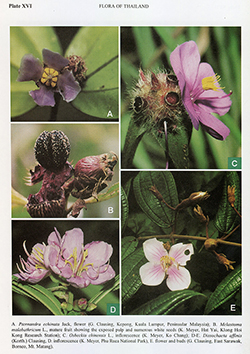e-Flora of Thailand
Volume 7 > Part 3 > Year 2001 > Page 421 > Melastomataceae > Dissochaeta
1. Dissochaeta affinis (Korth.) Clausingwfo-0000158394
comb. nov.— Marumia affinis Korth., Verh. Nat. Gesch. Ned. Bezitt., Bot. 241, pl. 60. 1844. Plate XVI: D–E.
Accepted Name : Macrolenes nemorosa (Jack) Bakh.f.
Rec. Trav. Bot. Néerl. 40: 206. 1943.
Synonyms & Citations :
Description : Scrambling shrub or woody climber, branchlets covered with persistent, brown or dark red-brown stellate hairs, nodes with undulate interpetiolar ridges. Leaves elliptic, 9–16 x 4–9 cm, base rounded to cordate, apex acuminate, tip ca 5 mm long, lamina with 2–3 pairs of lateral primary veins, young leaves covered with a stellate tomentum on both surfaces, mature mostly glabrous, petioles 0.8–1 cm long, covered with stellate hairs. Inflorescence axillary with three flowers, 5–6 cm long, bracts 12–15 mm long, lanceolate or subulate. Hypanthium tubular to urceolate, 8–15 mm long, densely covered with a brown or red-brown stellate indumentum and sometimes sparsely pustulate; calyx lobes obovate to triangular, 7–15 mm long, on the inside with a prominent vertical midridge. Petals suborbicular, about 25 mm long, pinkish-white. Stamens 8, dimorphic, episepalous (outer) ones with L-shaped anthers, about 12 mm long, connective prolongation below the anthers ca 8 mm long, basally enlarged into a membranaceous ring bearing numerous up to 4 mm long filiform appendages, epipetalous (inner) stamens with S-shaped anthers, about 15 mm long, connective barely prolonged below the anthers but ventrally with up to 6 mm long filiform appendages. Berry dry and somewhat woody, urceolate, 7–10 mm across, usually covered with stellate hairs.
Thailand : PENINSULAR: Ranong, Surat Thani, Phangnga (Kapong, Takuapa – type of Marumia impressa: Kerr 17110 -BK K), Krabi, Nakhon Si Thammarat, Phatthalung, Trang, Satun, Songkhla, Yala (Bannang Sata – type of M. dimorpha: Kerr 7283 -BK K), Narathiwat.
Distribution : Malay Peninsula, Sumatra, Borneo (Bandjermasin: Gunong Sakoembang – type of Marumia affinis: Korthals s.n. -L).
Ecology : Along margins of evergreen primary or secondary forests, from sea level to 1,000 m alt. Flowering and fruiting: year-round.
Vernacular : Lep yiao (เล็บเหยี่ยว)(Pattani).
Notes: Dissochaeta affinis is related to D. echinulata and D. reformata. It differs mainly in the indumentum of the hypanthium and in details of stamen morphology.
The younger name Marumia affinis Korth, is here taken up for this species because the epithet nemorosa is already occupied by Dissochaeta nemorosa G.Don.

